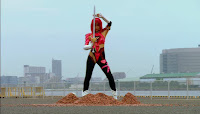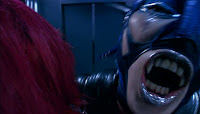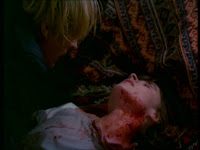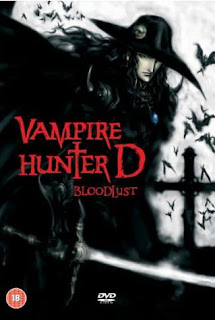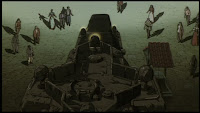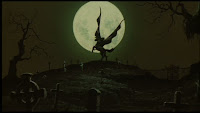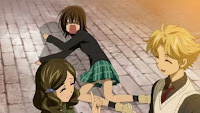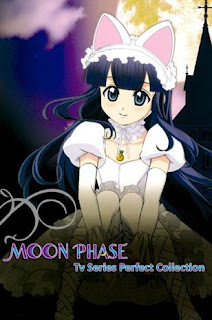 Director: Christopher Coppola
Director: Christopher Coppola
First Released: 1988
Contains spoilers
Familial ties seem to be everything when it comes to Dracula. We have had films about the Son of Dracula and Dracula’s Daughter – both from the Universal stable and only the tip of the iceberg when it comes to Dracula’s extended family on film. I’m only surprised that we haven’t had a film entitled Dracula’s Cousin (by Marriage) Eight Times Removed – go on, I dare you to show me there was one with that title!
Given that the 'brides' who appear in the novel seemed more like concubines, it is with some surprise that Christopher Coppola informs us that Dracula had a ‘true wife’, Vanessa – the eponymous widow. Now Vanessa is played by Sylvia Kristel and so I have to state, yes *that* Sylvia Kristel but get your mind out of the gutter, the film has very little nudity – and not from Ms Kristel – and no sex.
 I wanted to like this, but it is so referential and (other than in one respect) not in a good way, as well as being so full of plot points so ill explained and fantastical that we could only call them craptacular. Despite that I do think it inspired another moment in a later vampire movie. The film starts off with a voice over by police Detective Hap Lannon (Josef Sommer), convinced he was in a film noir. He draws our attention to where it all started – the Hollywood House of Wax, and already we have a narrator who we know will survive. Actually the fact that he seems to be the world’s worst detective, or at least the world’s most laid back detective, is part of the craptacular plotting.
I wanted to like this, but it is so referential and (other than in one respect) not in a good way, as well as being so full of plot points so ill explained and fantastical that we could only call them craptacular. Despite that I do think it inspired another moment in a later vampire movie. The film starts off with a voice over by police Detective Hap Lannon (Josef Sommer), convinced he was in a film noir. He draws our attention to where it all started – the Hollywood House of Wax, and already we have a narrator who we know will survive. Actually the fact that he seems to be the world’s worst detective, or at least the world’s most laid back detective, is part of the craptacular plotting.
 The fact that we are in a House of Wax immediately brings to mind Bud Abbott and Lou Costello meet Frankenstein, especially as the proprietor, Raymond Everett (Lenny Von Dohlen) is setting up a Dracula exhibition and has received crates from Romania – expecting five only, number sex contains Vanessa. Two things – both craptacular plot points – how did she get shipped over? Why was she in a crate? These are not answered. Also, what was with Raymond’s affected accent – he sounded like a right dick… that said I now feel certain that Coppola’s brother, Nick Cage, took said accent for his character in the next year’s Vampire’s Kiss, and this is the inspiring a later film that I spoke of… The problem is Nick Cage was meant to be annoying and irredeemable in his film, in this Raymond is the nearest thing we get to a central hero.
The fact that we are in a House of Wax immediately brings to mind Bud Abbott and Lou Costello meet Frankenstein, especially as the proprietor, Raymond Everett (Lenny Von Dohlen) is setting up a Dracula exhibition and has received crates from Romania – expecting five only, number sex contains Vanessa. Two things – both craptacular plot points – how did she get shipped over? Why was she in a crate? These are not answered. Also, what was with Raymond’s affected accent – he sounded like a right dick… that said I now feel certain that Coppola’s brother, Nick Cage, took said accent for his character in the next year’s Vampire’s Kiss, and this is the inspiring a later film that I spoke of… The problem is Nick Cage was meant to be annoying and irredeemable in his film, in this Raymond is the nearest thing we get to a central hero.
 He retires upstairs and, as he does, we see the crate rattle and glow red. A note re the lighting. There is some unusual lighting work through the film. Bold reds are often used with Vanessa and there are some strange uses of green, quite a neon feel that to be honest felt like it was lifted directly from the film Vamp. Anyway, Raymond thinks he has heard something and goes downstairs – the door is open and he exclaims about the spate of recent break-ins. At a jazz bar one of the regular’s notices a woman (Vanessa) walk in – he doesn’t however seem to notice or care about how stiffly she walks. He takes her off to the park and after some brief fumbling on the grass she attacks.
He retires upstairs and, as he does, we see the crate rattle and glow red. A note re the lighting. There is some unusual lighting work through the film. Bold reds are often used with Vanessa and there are some strange uses of green, quite a neon feel that to be honest felt like it was lifted directly from the film Vamp. Anyway, Raymond thinks he has heard something and goes downstairs – the door is open and he exclaims about the spate of recent break-ins. At a jazz bar one of the regular’s notices a woman (Vanessa) walk in – he doesn’t however seem to notice or care about how stiffly she walks. He takes her off to the park and after some brief fumbling on the grass she attacks.
 In a moment of craptacular plotting the House of Wax is broken in to. I mean, he assumes a break-in earlier due to the number of them, one supposes, this place must have the worst locks and alarms ever. One of the robbers goes through to find the cash register when he hears his partner, Dave (J Michael Hunter), scream. He runs into a bloody mess, with Vanessa feeding, and legs it. Bizarrely Raymond, upstairs, hears nothing.
In a moment of craptacular plotting the House of Wax is broken in to. I mean, he assumes a break-in earlier due to the number of them, one supposes, this place must have the worst locks and alarms ever. One of the robbers goes through to find the cash register when he hears his partner, Dave (J Michael Hunter), scream. He runs into a bloody mess, with Vanessa feeding, and legs it. Bizarrely Raymond, upstairs, hears nothing.
Vanessa goes upstairs and Raymond is watching Nosferatu (so, to reiterate he heard nothing this time - despite hearing her break out earlier - possibly it was drowned out by the soundtrack of the silent film!) This film really does reference the 1922 classic a lot, which is the good referencing. From a shadow moment in this scene, to the behaviour in the next scene of Raymond’s girlfriend Jenny (Rachel Jones), there is a reverential referencing of Murnau. The way Kristel moves and acts mimics Max Schreck so that, when I hear complaints about her performance, I feel the point has been missed. She even carries her crate, at one point, in a reproduction of Orlock carrying his crate through Bremen.
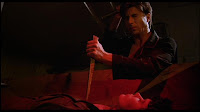 However, even here the plot becomes craptacular. Vanessa decides to make Raymond her slave and then force him to take her back to Romania and her husband, Dracula. Raymond states that Dracula is dead – killed by Van Helsing – and she does not believe it. Later, Van Helsing’s grandson (Stefan Schnabel), reveals that his grandfather killed off all the vampires bar Vanessa, so what happened to her? Where has she been for just shy of 100 years (her clothes look non-contemporary but newer than the 19th century)? How could she not know that Dracula was dead? We come back to the question 'just what was she doing in that damn crate?'
However, even here the plot becomes craptacular. Vanessa decides to make Raymond her slave and then force him to take her back to Romania and her husband, Dracula. Raymond states that Dracula is dead – killed by Van Helsing – and she does not believe it. Later, Van Helsing’s grandson (Stefan Schnabel), reveals that his grandfather killed off all the vampires bar Vanessa, so what happened to her? Where has she been for just shy of 100 years (her clothes look non-contemporary but newer than the 19th century)? How could she not know that Dracula was dead? We come back to the question 'just what was she doing in that damn crate?'
 As Raymond is attacked Jenny begins to sleep walk and her walk takes her out of her house and she looks up at a neon cross on a church. This sleepwalking as a telepathic reaction to his danger was very much like Ellen in Nosferatu but there really is no comparison character wise. Ellen was drawn as a self-less woman, whose act of self sacrifice at the end of the movie was both noble and touching. Jenny is a cipher, whose seemingly psychic ability is there only to pull us to the final frames of the film but who, as a character, is empty and devoid of personality.
As Raymond is attacked Jenny begins to sleep walk and her walk takes her out of her house and she looks up at a neon cross on a church. This sleepwalking as a telepathic reaction to his danger was very much like Ellen in Nosferatu but there really is no comparison character wise. Ellen was drawn as a self-less woman, whose act of self sacrifice at the end of the movie was both noble and touching. Jenny is a cipher, whose seemingly psychic ability is there only to pull us to the final frames of the film but who, as a character, is empty and devoid of personality.
 The lore is fairly standard, Vanessa avoids the sunlight (though we never witness exposure to sunlight in the film). Bitten victims turn but it takes time – allowing Helsing time to get to Hap and take him to a morgue so that he can stake a vampire (who unusually doesn’t rise when they get there) so that Hap can see the corpse react to staking (open eyes and yell out). However, when a bite could put a hero in jeopardy by turning the victim immediately it does. The cross is a definite deterrent and, in one moment that actually makes this film partially worthwhile, when Vanessa is confronted by a cross she sheds one solitary blood tear (whilst saying she is cursed). The fact that the tear was a delicate pink worked really well, as though the tear was simply stained with blood.
The lore is fairly standard, Vanessa avoids the sunlight (though we never witness exposure to sunlight in the film). Bitten victims turn but it takes time – allowing Helsing time to get to Hap and take him to a morgue so that he can stake a vampire (who unusually doesn’t rise when they get there) so that Hap can see the corpse react to staking (open eyes and yell out). However, when a bite could put a hero in jeopardy by turning the victim immediately it does. The cross is a definite deterrent and, in one moment that actually makes this film partially worthwhile, when Vanessa is confronted by a cross she sheds one solitary blood tear (whilst saying she is cursed). The fact that the tear was a delicate pink worked really well, as though the tear was simply stained with blood.
 Vampires can become ravening beasts and seemed to attack at random. Vanessa spots a pentagram and takes Raymond to a satanic ritual where the leader of the Satanists seems to sense her power. She suddenly goes nuts and kills them all. Why? A throw away comment about them not being worthy, perhaps, or just playing at Satanists might have been useful. It would have been interesting if she was opposed to them because of their blasphemy of a God she was unable to worship but still loved. However, it is just silly and random and an excuse for gore.
Vampires can become ravening beasts and seemed to attack at random. Vanessa spots a pentagram and takes Raymond to a satanic ritual where the leader of the Satanists seems to sense her power. She suddenly goes nuts and kills them all. Why? A throw away comment about them not being worthy, perhaps, or just playing at Satanists might have been useful. It would have been interesting if she was opposed to them because of their blasphemy of a God she was unable to worship but still loved. However, it is just silly and random and an excuse for gore.
 The main killing technique we hear of is staking and should one bitten but not yet fully turned stake the one who bit him/her, by their own hand, they will be freed from the curse. Vampires can turn into bats and part of me wishes they couldn’t in this movie, whilst another part of me revels in the absolute audacity of the Crap Bat Syndrome they throw into this. The filmmakers spare us this one until the very end and, first of, we get a flying bat that is so badly imposed onto film it is untrue.
The main killing technique we hear of is staking and should one bitten but not yet fully turned stake the one who bit him/her, by their own hand, they will be freed from the curse. Vampires can turn into bats and part of me wishes they couldn’t in this movie, whilst another part of me revels in the absolute audacity of the Crap Bat Syndrome they throw into this. The filmmakers spare us this one until the very end and, first of, we get a flying bat that is so badly imposed onto film it is untrue.
 Vanessa (for it is she) then flies round a warehouse or factory and we get an over shoulder point of view of some bad creature creation that then attaches itself to hapless victim’s neck and looks so bad it beggars belief. Not since the invisible bats and hand puppet bats of the Devil’s Plaything has a moment of Crap Bat Syndrome been so crap and thus so worthwhile.
Vanessa (for it is she) then flies round a warehouse or factory and we get an over shoulder point of view of some bad creature creation that then attaches itself to hapless victim’s neck and looks so bad it beggars belief. Not since the invisible bats and hand puppet bats of the Devil’s Plaything has a moment of Crap Bat Syndrome been so crap and thus so worthwhile.
The film is, in many respects, horrible. Badly plotted, no atmosphere and no protagonist we actually care about. But it has moments shining through, even if they are just moments. 3.5 out of 10 is bolstered by the moments that are worthwhile. The imdb page is here.
 In this episode the soul is a vampire (Heather Doerksen) – or at least she was a murderess who drank blood and believes herself to be a vampire. When the devil hands Sam his task he also hands over the vessel – which in this case was a wooden stake – with a quip about Sam looking like Buffy (referring, of course, to the vampire slayer).
In this episode the soul is a vampire (Heather Doerksen) – or at least she was a murderess who drank blood and believes herself to be a vampire. When the devil hands Sam his task he also hands over the vessel – which in this case was a wooden stake – with a quip about Sam looking like Buffy (referring, of course, to the vampire slayer).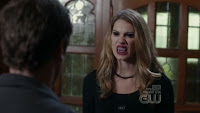 Sam, Sock and Ben enter the mansion to get her, and whilst it is daylight she is likely around as she is a soul rather than a real vampire (the devil has said there is no such thing and yet at this point Sam has been reunited with his earthly father, who died at the end of season 1 and is now a zombie). The guys are impressed with the Emo look of the place. When the vampire appears she is protecting something and has a maw of fangs (souls take on chosen forms and abilities).
Sam, Sock and Ben enter the mansion to get her, and whilst it is daylight she is likely around as she is a soul rather than a real vampire (the devil has said there is no such thing and yet at this point Sam has been reunited with his earthly father, who died at the end of season 1 and is now a zombie). The guys are impressed with the Emo look of the place. When the vampire appears she is protecting something and has a maw of fangs (souls take on chosen forms and abilities). She attacks but Sam manages to stake her when she is on Sock’s back, going for the neck. This is very early on in the episode as the main thrust does not surround capturing her soul but the thing she was protecting – a baby. The baby is an iboh (intentional birth out of Hell) and thus the episode only gets an honourable mention as the vampire aspect was within the first 10 minutes or so. However the show is really worth watching, laugh out loud funny in places with some seriously weird supernatural aspects that make it one of the most original shows being aired. All the acting is very good, but especially look out for Tyler Labine as Sock and Ray Wise who easily ranks up there with the best on-screen portrayals of Satan.
She attacks but Sam manages to stake her when she is on Sock’s back, going for the neck. This is very early on in the episode as the main thrust does not surround capturing her soul but the thing she was protecting – a baby. The baby is an iboh (intentional birth out of Hell) and thus the episode only gets an honourable mention as the vampire aspect was within the first 10 minutes or so. However the show is really worth watching, laugh out loud funny in places with some seriously weird supernatural aspects that make it one of the most original shows being aired. All the acting is very good, but especially look out for Tyler Labine as Sock and Ray Wise who easily ranks up there with the best on-screen portrayals of Satan.




